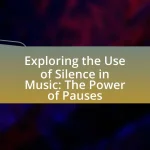The article focuses on the essential elements of writing effective melodies, aimed at aspiring composers. It outlines the characteristics that define memorable melodies, such as simplicity, emotional resonance, and structural coherence, while emphasizing the importance of rhythm and pitch in enhancing melody effectiveness. The article also discusses the role of harmony, common mistakes to avoid, and practical techniques for creating engaging melodies, including motif development and improvisation. Additionally, it highlights various tools and resources, such as software applications and online courses, that can aid composers in refining their melody writing skills.

What are Effective Melodies?
Effective melodies are musical phrases that are memorable, engaging, and evoke emotional responses. They typically feature a clear structure, often utilizing repetition and variation to enhance listener retention. Research indicates that effective melodies often adhere to specific intervals and rhythmic patterns, which contribute to their appeal. For instance, the use of the pentatonic scale is common in many successful melodies, as it provides a pleasing sound that resonates with listeners.
How do melodies impact musical composition?
Melodies significantly impact musical composition by serving as the primary vehicle for expressing emotion and thematic material. They create memorable hooks that engage listeners, guiding the overall structure and development of a piece. For instance, in classical music, composers like Beethoven utilized distinct melodic lines to convey specific moods and ideas, which shaped the listener’s experience and understanding of the work. Additionally, research indicates that melodies influence cognitive processing in music, affecting how audiences perceive and remember compositions. This underscores the importance of crafting effective melodies in the compositional process.
What elements define a memorable melody?
A memorable melody is defined by its simplicity, catchiness, emotional resonance, and distinctiveness. Simplicity allows listeners to easily remember and sing along, while catchiness often stems from rhythmic patterns and repetition that engage the audience. Emotional resonance connects the melody to feelings, enhancing its impact, and distinctiveness ensures it stands out from other melodies. Research indicates that melodies with these characteristics are more likely to be retained in memory, as evidenced by studies showing that simple and repetitive tunes are easier for people to recall and recognize.
Why is melody important in different music genres?
Melody is crucial in different music genres because it serves as the primary means of conveying emotion and identity within a piece. In genres like pop, catchy melodies drive commercial success and audience engagement, while in classical music, intricate melodies showcase compositional skill and evoke deep emotional responses. For instance, the use of memorable melodic hooks in pop music has been shown to increase listener retention and popularity, as evidenced by studies indicating that songs with strong melodic lines tend to perform better on music charts. In jazz, improvisational melodies allow for personal expression and creativity, highlighting the genre’s emphasis on individual artistry. Thus, melody not only defines the character of a genre but also enhances its emotional impact and listener appeal.
What characteristics make a melody effective?
An effective melody is characterized by its memorability, emotional resonance, and structural coherence. Memorability is achieved through simple, catchy phrases that are easy for listeners to recall, often utilizing repetition and variation. Emotional resonance is created by incorporating dynamics, phrasing, and tonal choices that evoke feelings, as seen in popular songs that connect with audiences on a personal level. Structural coherence involves a clear organization of musical ideas, typically following established forms such as verse-chorus or ABA, which helps listeners navigate the melody easily. These characteristics are supported by studies in music cognition, which show that melodies that balance familiarity and novelty tend to be more engaging and memorable.
How do rhythm and pitch contribute to melody effectiveness?
Rhythm and pitch are fundamental elements that significantly enhance melody effectiveness. Rhythm provides the temporal structure that dictates the timing and flow of notes, creating a sense of movement and engagement. For instance, varying note durations and patterns can evoke different emotional responses, as seen in the works of composers like Beethoven, who used rhythmic complexity to heighten tension and drama in his melodies.
Pitch, on the other hand, determines the frequency of notes, which influences the melody’s emotional character and memorability. Specific intervals, such as major and minor thirds, can convey happiness or sadness, respectively. Research by music theorist David Huron indicates that melodies with a clear tonal center and well-defined pitch contours are more likely to be remembered and appreciated by listeners.
Together, rhythm and pitch create a cohesive musical narrative that captures attention and elicits emotional responses, making them essential for crafting effective melodies.
What role does harmony play in shaping a melody?
Harmony plays a crucial role in shaping a melody by providing the underlying structure and emotional context that enhances the melodic line. The interaction between harmony and melody creates tension and resolution, guiding the listener’s emotional response. For instance, in Western music, the use of chord progressions, such as the common I-IV-V-I progression, establishes a tonal framework that supports and complements the melody, making it more memorable and impactful. This relationship is evident in classical compositions, where composers like Bach and Beethoven skillfully integrated harmony to elevate their melodic ideas, demonstrating that harmony is essential for creating depth and richness in musical expression.

How Can Aspiring Composers Write Effective Melodies?
Aspiring composers can write effective melodies by focusing on simplicity, repetition, and emotional resonance. Simple melodies are easier for listeners to remember and can be more impactful; for instance, many popular songs utilize straightforward melodic lines. Repetition helps to reinforce the melody, making it more recognizable, as seen in the structure of many hit songs where a catchy hook is repeated. Additionally, incorporating emotional elements, such as dynamics and phrasing, can enhance the listener’s connection to the melody, as evidenced by the success of composers like Beethoven, who effectively used these techniques to evoke strong feelings in his audience.
What techniques can be used to create engaging melodies?
To create engaging melodies, composers can utilize techniques such as motif development, contrasting dynamics, and rhythmic variation. Motif development involves taking a short musical idea and expanding upon it, which helps to create familiarity and interest. Contrasting dynamics, such as alternating between loud and soft passages, can evoke emotional responses and maintain listener engagement. Rhythmic variation introduces unexpected patterns or syncopation, which keeps the melody fresh and captivating. These techniques are supported by the principles of music theory, which emphasize the importance of balance and contrast in composition.
How does improvisation enhance melody writing?
Improvisation enhances melody writing by fostering creativity and spontaneity in the composition process. When composers engage in improvisation, they explore various melodic ideas without the constraints of pre-planned structures, allowing for the discovery of unique and unexpected musical phrases. This practice has been shown to stimulate the brain’s creative pathways, as evidenced by studies indicating that improvisation activates areas associated with divergent thinking, which is crucial for generating novel musical concepts. Additionally, improvisation encourages a deeper emotional connection to the music, as composers can express their feelings in real-time, resulting in melodies that resonate more profoundly with listeners.
What are the benefits of using motifs in melody composition?
Using motifs in melody composition enhances thematic coherence and emotional impact. Motifs serve as recognizable musical ideas that can be developed and varied throughout a piece, creating unity and helping listeners connect with the music. For example, Beethoven frequently employed motifs in his symphonies, allowing him to build complex structures while maintaining a clear identity. This technique not only aids in memorability but also facilitates the exploration of different musical ideas, enriching the overall composition.
What common mistakes should composers avoid when writing melodies?
Composers should avoid common mistakes such as overcomplicating melodies, neglecting melodic contour, and failing to establish a strong tonal center. Overcomplicating melodies can lead to confusion and make it difficult for listeners to remember the tune, as evidenced by the principle that simpler melodies are often more memorable. Neglecting melodic contour can result in a lack of emotional impact, as effective melodies typically have a clear rise and fall that engages the listener. Additionally, failing to establish a strong tonal center can create dissonance that detracts from the overall coherence of the piece, which is crucial for maintaining listener interest and emotional connection.
How can repetition be misused in melody writing?
Repetition can be misused in melody writing by leading to monotony and a lack of emotional impact. When a melody relies too heavily on repeated phrases without variation, it can cause listener fatigue and diminish engagement. For instance, if a composer repeats the same melodic line multiple times without introducing new elements or dynamics, the piece may feel stagnant and uninspired. This is particularly evident in popular music, where excessive repetition can result in songs that fail to resonate with audiences, as seen in critiques of tracks that overuse hooks without development.
What pitfalls exist in melody structure and development?
Pitfalls in melody structure and development include lack of coherence, over-complexity, and monotony. Coherence is essential for a melody to be memorable; without it, listeners may struggle to connect with the piece. Over-complexity can lead to confusion, as intricate melodies may lose their emotional impact and become difficult to follow. Monotony arises when melodies fail to introduce variation, making them predictable and unengaging. Research indicates that effective melodies often balance repetition and variation to maintain listener interest, as seen in popular music trends where hooks are repeated with slight modifications to enhance appeal.

What Tools and Resources Can Help in Melody Writing?
Software applications such as MuseScore, Sibelius, and Finale are essential tools for melody writing, as they provide composers with notation capabilities and playback features. These programs allow users to create, edit, and visualize musical scores, facilitating the composition process. Additionally, digital audio workstations (DAWs) like Ableton Live, Logic Pro, and FL Studio offer extensive resources for melody writing through MIDI sequencing, virtual instruments, and audio manipulation. Online platforms such as Hooktheory and Soundtrap also support melody creation by providing interactive tools and collaborative environments. Research indicates that using these tools can enhance creativity and efficiency in music composition, making them invaluable resources for aspiring composers.
What software and apps are available for melody composition?
Several software and apps are available for melody composition, including Ableton Live, FL Studio, Logic Pro X, GarageBand, MuseScore, and Sibelius. These tools provide various features such as MIDI sequencing, audio recording, and notation capabilities, which facilitate the creation of melodies. For instance, Ableton Live is known for its intuitive interface and real-time performance capabilities, while FL Studio offers a comprehensive suite of plugins for sound design. Logic Pro X is favored for its extensive library of sounds and loops, and GarageBand serves as a user-friendly option for beginners. MuseScore and Sibelius are specifically designed for music notation, allowing composers to write and arrange melodies effectively.
How can music theory resources aid in writing effective melodies?
Music theory resources aid in writing effective melodies by providing foundational knowledge about scales, intervals, and chord progressions. Understanding scales allows composers to select appropriate notes that create a desired mood, while knowledge of intervals helps in crafting melodic contours that are engaging and memorable. Additionally, music theory explains how chord progressions function, enabling composers to create harmonically rich melodies that complement the underlying chords. This structured approach to melody writing is supported by studies showing that melodies based on established theoretical principles tend to resonate more with listeners, enhancing their emotional impact.
What role do online courses play in developing melody writing skills?
Online courses play a significant role in developing melody writing skills by providing structured learning, expert guidance, and practical exercises. These courses often include video tutorials, interactive assignments, and feedback from instructors, which help learners understand the principles of melody creation, such as scale usage, rhythm, and harmony. Research indicates that structured learning environments, like those found in online courses, enhance skill acquisition by offering a clear progression of concepts and techniques, thereby facilitating the mastery of melody writing.
What are some practical tips for aspiring composers to improve their melodies?
Aspiring composers can improve their melodies by practicing the use of motifs, which are short, memorable musical ideas that can be developed throughout a piece. This technique is supported by the fact that many successful compositions, such as Beethoven’s symphonies, utilize motifs to create cohesion and emotional impact. Additionally, composers should experiment with varying rhythm and phrasing to add interest; studies show that rhythmic diversity can enhance listener engagement. Another effective strategy is to analyze and learn from existing melodies in various genres, as this can provide insights into effective melodic construction and inspire new ideas.
How can listening to various genres inspire melody creation?
Listening to various genres can inspire melody creation by exposing composers to diverse musical structures, rhythms, and emotional expressions. Each genre, such as jazz, classical, or hip-hop, employs unique melodic techniques and harmonic progressions that can spark new ideas. For instance, jazz often incorporates improvisation and syncopation, which can lead to innovative melodic lines, while classical music may offer rich counterpoint and thematic development. Research indicates that exposure to a wide range of musical styles enhances creativity and can lead to the development of original melodies, as demonstrated in studies on music cognition that show how genre blending can result in novel compositions.
What exercises can help refine melody writing skills?
To refine melody writing skills, composers can engage in exercises such as transcribing melodies from existing songs, improvising melodies over chord progressions, and utilizing melodic contour exercises. Transcribing melodies helps develop an ear for structure and phrasing, while improvisation encourages creativity and spontaneity in melody creation. Melodic contour exercises focus on varying pitch and rhythm to create engaging melodies. These methods are supported by music education research, which emphasizes the importance of active engagement in learning to enhance compositional skills.


